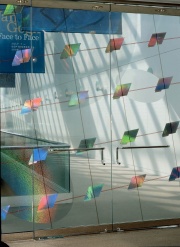Laminated glass
Description
Two sheets of glass with a thin layer of vinyl plastic adhered between. First patented in 1910, laminated glass was used during World War I to strengthened the windshields of military vehicles. After the war, Safety glass was adapted for use in automobile windshields and skylights. When broken, the glass fragments remain attached to the plastic rather than scattering. The interlayer is usually polyvinyl butyral (PVB). The PVB interlayer also gives the glass a much higher sound insulation rating, due to the damping effect, and also blocks most of the incoming UV radiation (88% in window glass and 97.4% in windscreen glass).
For additional information, see:
- Exhibit Guidelines Technical Notes: Selecting Exhibit Glazing
- Exhibit Guidelines Technical Notes: Security Glazing for Exhibit
Synonyms and Related Terms
safety glass; verre laminé (Fr.); verre calandré (Fr.); gelaagd glas (Ned.); vidro laminado (Port.)
Applications
- Architecture, glazing, automobile windows
- UV protection, skylights
- Weather resistance (hurricanes, wind, etc.) in store fronts and windows.
- Sound reduction
Resources and Citations
- Wikipedia: Laminated glass Accessed Nov. 2024
